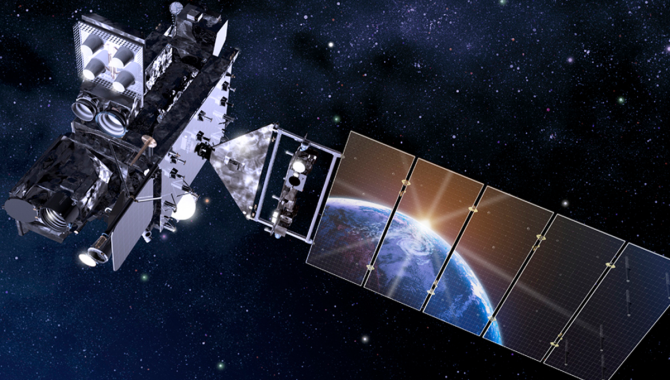On September 24, 2025, NASA and NOAA (National Oceanic and Atmospheric Administration )successfully launched three pioneering spacecraft destined to transform the monitoring of space weather and safeguard Earth’s vital systems from solar storms. The missions lifted off aboard a SpaceX Falcon 9 rocket from Kennedy Space Center’s Launch Complex 39A at 7:35 a.m. EDT, beginning a new era in solar storm prediction and heliospheric research.
Pioneering Space Weather Surveillance
At the heart of this launch is NOAA’s Space Weather Follow-On Lagrange 1 (SWFO-L1) spacecraft, the agency’s first dedicated operational satellite designed exclusively for continuous space weather observation. Poised approximately one million miles from Earth at the Lagrange Point 1, SWFO-L1 will deliver unprecedented early warnings of solar activity such as coronal mass ejections (CMEs) and solar storms — natural phenomena capable of disrupting power grids, navigational systems, satellite communications, and various critical infrastructures.
Equipped with a state-of-the-art coronagraph capable of capturing solar eruption images within 30 minutes, SWFO-L1 drastically improves on older satellites that had delays of up to eight hours. This rapid detection offers vital 15 to 45 minutes of lead time for operators to enact safety measures safeguarding key infrastructure from space weather hazards. Rob Wallace from NOAA’s Space Weather Prediction Center likened the mission to “deploying a buoy a million miles from Earth to protect our way of life,” highlighting its essential role in maintaining Earth’s safety and technological stability.
Mapping the Heliosphere with NASA’s IMAP
Complementing SWFO-L1 is NASA’s Interstellar Mapping and Acceleration Probe (IMAP), a trailblazing mission designed to create the most detailed maps ever produced of the heliosphere — the magnetic bubble enveloping our solar system. The heliosphere acts as a vital shield, blocking roughly 75 percent of harmful galactic cosmic radiation from reaching Earth’s atmosphere.
IMAP’s ten sophisticated instruments will analyze solar wind particles and study their interaction with the boundary between the solar system and interstellar space. This research is crucial not only for scientific understanding but also for ensuring astronaut safety and mission planning for human space exploration beyond Earth’s immediate environment. David McComas, IMAP’s principal investigator at Princeton University, emphasized that understanding the heliosphere’s dynamics is “undoubtedly vital for human exploration beyond the near-Earth environment”.
Observing Earth’s Outer Atmosphere
The third spacecraft is NASA’s Carruthers Geocorona Observatory, named in honor of Dr. George Carruthers, a pioneer who developed the first ultraviolet camera to photograph the Earth’s geocorona during the Apollo 16 mission. This mission will continually observe Earth’s outermost atmospheric layer, the exosphere, shedding light on how space weather impacts our planet’s protective boundary extending halfway to the Moon. This research promises to deepen knowledge of the interactions between solar wind and Earth’s atmosphere, improving predictions of space weather effects on terrestrial and satellite systems.
Addressing Growing Space Weather Risks
These three missions address increasing concerns regarding space weather’s potential to disrupt modern technologies. From GPS navigation and satellite communications to power grids and aviation safety, solar storms pose real and escalating risks. The combined $1.57 billion investment represents a major upgrade to space weather monitoring capabilities, replacing aging systems some of which have been operational for over three decades. This enhancement is timely as space weather phenomena grow more frequent and intense, impacting not only Earth but also the growing number of space-based assets and astronauts venturing beyond Earth’s orbit.
Efficient Launch and Path to Operations
The trio shared a single Falcon 9 flight — a cost-effective ride facilitated by efficient payload integration. Following successful separation and signal acquisition shortly after launch, the spacecraft are en route to their operational destinations. Both SWFO-L1 and IMAP will arrive near the Lagrange Point 1 in early 2026, a gravitationally stable point between Earth and the Sun providing uninterrupted solar observation. Meanwhile, the Carruthers Observatory will begin its mission focused on Earth’s exosphere following commissioning.
A Critical Step for Future Space Exploration
These missions herald significant scientific and practical advancements in understanding and mitigating space weather effects. By enabling earlier warnings and deeper insights into solar and cosmic phenomena, NASA and NOAA are strengthening Earth’s resilience and paving the way for safer human exploration of the Moon, Mars, and beyond. This launch is a vital step in protecting modern civilization’s infrastructure and ensuring humanity’s sustainable presence in space.

